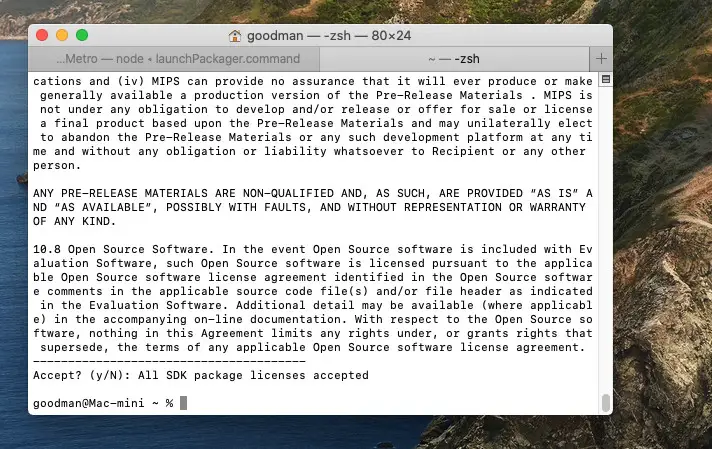- Set ANDROIDHOME environment variable in mac. Ask Question Asked 5 years, 10 months ago. Active 2 months ago. Viewed 136k times 72. I am new in developing native app using Salesforce SDK. I tried to create android project from command line using forcedroid tool but there is problem in setting environment variable named ANDROIDHOME.
- Note for me to remember how to set Android Home on Mac: Open Terminal and type in. Nano /.bashprofile: Add the below paths: The path should be where your android installation is located.
- Mac Android Studio Gradle Home
- Android Home Variable Mac
- Mac Android Home
- Mac Android_home
- Mac Android_home Environment Variable
This tutorial will show you how to install and set up React Native (with the React Native CLI) for Android development, on macOS. Note: If you already set up your Mac to run React Native on the iOS simulator (via Xcode), as shown in this tutorial then you already installed Node.js & Watchman and can skip that step and go right to the install Java Development Kit step.
Question or issue on macOS:
Could anybody post a working solution for setting ANDROID_HOME via the terminal?
My path to the Android-SDK is /Applications/ADT/sdk.
Mac Android Studio Gradle Home
How to solve this problem?
Solution no. 1:
Where the Android-SDK is installed depends on how you installed it.
If you downloaded the SDK through their website and then dragged/dropped the Application to your Applications folder, it’s most likely here:
/Applications/ADT/sdk(as it is in your case).If you installed the SDK using Homebrew (
brew cask install android-sdk), then it’s located here:/usr/local/Caskroom/android-sdk/{YOUR_SDK_VERSION_NUMBER}If the SDK was installed automatically as part of Android Studio then it’s located here:
Download Minecraft - Pocket Edition MOD premium skins 1.16.100.50 Explore infinite worlds and build everything from the simplest of homes to the grandest of castles. Play in creative mode with unlimited resources or mine deep into the world in survival mode, crafting weapons and armor to fend off dangerous mobs. MCPE v1.1.1.0 Mod 1.1.1.0 Apk download link. Need the Latest Minecraft Mod Apk? Download Minecraft Mod APK On HappyMod. Download Minecraft Mod APK. Explore infinite worlds and build everything from the simplest of homes to the grandest of castles. Play in creative mode with unlimited resources or mine deep into the world. Mcpe 1.1 0.5 apk download apk.
/Users/{YOUR_USER_NAME}/Library/Android/sdk
Once you know the location, open a terminal window and enter the following (changing out the path to the SDK to be however you installed it):
Once you have this set, you need to add this to the PATH environment variable:
Lastly apply these changes by re-sourcing .bash_profile:

source ~/.bash_profile
- Type – echo $ANDROID_HOME to check if the home is set.
Android Home Variable Mac
echo $ANDROID_HOME
Solution no. 2:
In Terminal:
Add lines:
Check it worked:
Solution no. 3:
Adding the following to my .bash_profile worked for me:
Solution no. 4:
quoting @user2993582’s answer

The ‘bin’ part has changed and it should be
Mac Android Home
Solution no. 5:
I am having MAC OS X(Sierra) 10.12.2.
I set ANDROID_HOME to work on React Native(for Android apps) by following the following steps.
- Open Terminal (press Command+R, type Terminal, Hit ENTER).
Add the following 3 lines to ~/.bash_profile.
Finally execute the below command (or RESTART the system to reflect the changes made).
source ~/.bash_profile
That’s it.
Solution no. 6:

Could anybody post a working solution for doing this in the terminal?
ANDROID_HOME is usually a directory like .android. Its where things like the Debug Key will be stored.
You can automate it for your login. Just add it to your .bash_profile (below is from my OS X 10.8.5 machine):
According to David Turner on the NDK Mailing List, both ANDROID_NDK_ROOT and ANDROID_SDK_ROOT need to be set because other tools depend on those values (see Recommended NDK Directory?).
After modifying ~/.bash_profile, then perform the following (or logoff and back on):
Solution no. 7:

To set ANDROID_HOME, variable, you need to know how you installed android dev setup.
If you don’t know you can check if the following paths exist in your machine. Add the following to .bashrc, .zshrc, or .profile depending on what you use
If you installed with homebrew,
Check if this path exists:
If you installed android studio following the website,
Finally add it to path:
If you’re too lazy to open an editor do this:
Solution no. 8:
I’m using React Native with Catalina mac os and zsh shell
1- touch ~/.zshrc
2- open ~/.zshrc
3- according to React Native android setup copy and past
to the opened text file then save and close the file.
4- run source ~/.zshrc
and make sure to restart your terminal.
5- run adb you will get something like
Android Debug Bridge version 1.0.41 Version 30.0.0-6374843
Download new versions, service packs, and add-ins for SOLIDWORKS, Simulation, PDM, and Free CAD Tools (eDrawings, Composer Player, SOLIDWORKS Explorer). Solidworks 32 bit windows 10. Solidworks 32 bit free download. Most people looking for Solidworks 32 bit free downloaded: SolidWorks. 3.7 on 631 votes. SolidWorks is a program that provides enhanced engineering and design performances that help you get your work done faster and easier. SolidWorks Explorer 2014. Solidworks 2017 free download 32 bit. Photo & Graphics tools downloads - SolidWorks by SolidWorks Corporation and many more programs are available for instant and free download.
thanks for this documented
Solution no. 9:
People, note that if you will use ~/.bash_profile then it will edit not your user’s bash profile, but global. Instead go to your users directory (/Users/username) and edit it directly:
And insert following two lines with respect to your Username and SDK directory
Solution no. 10:
Mac Android_home
Setup ANDROID_HOME , JAVA_HOME enviromental variable on Mac OS X
Add In .bash_profile file
For Test
Mac Android_home Environment Variable
Hope this helps!
